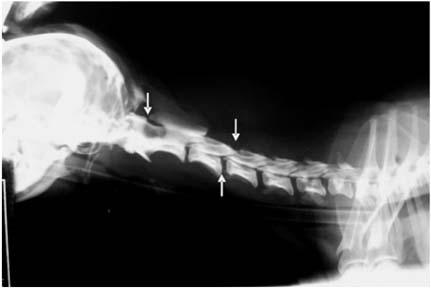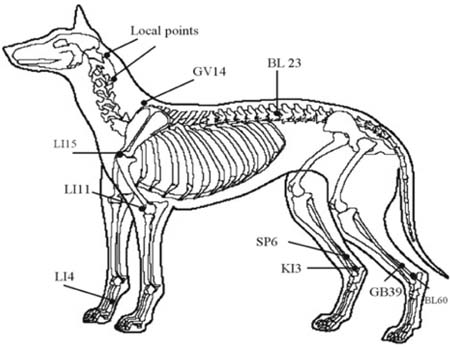J Vet Sci.
2007 Mar;8(1):95-98. 10.4142/jvs.2007.8.1.95.
Electro-acupuncture and Chinese herbs for treatment of cervical intervertebral disk disease in a dog
- Affiliations
-
- 1Department of Surgery, Faculty of Veterinary Medicine, University of Sao Paulo, Sao Paulo, Brazil. aynevet@usp.br
- 2Veterinary Hospital, Faculty of Veterinary Medicine, University of Sao Paulo, Sao Paulo, Brazil.
- KMID: 1104242
- DOI: http://doi.org/10.4142/jvs.2007.8.1.95
Abstract
- A non-ambulatory dog with tetraparesis following a pain episode that had evolved over 2 months was submitted for medical treatment and diagnosed with intervertebral disk disease at C3-C4 and dorsal extradural compression at C1-C2 and C3-C4 using myelography and computed tomography. The dog experienced ambulation recovery after 15 days of treatment with only electroacupuncture and Chinese herbal medicine, with marked improvement occurring after only 10 treatments. Six months of followup demonstrated that the dog was stable and had no recurrence of symptoms. Therefore, it was concluded that the combination of electroacupuncture and Chinese herbal medicine was responsible for motor rehabilitation.
Keyword
MeSH Terms
-
Animals
Cervical Vertebrae/*pathology
Dog Diseases/*drug therapy/*therapy
Dogs
Drugs, Chinese Herbal/*therapeutic use
Electroacupuncture/methods/*veterinary
*Intervertebral Disk
Myelography/veterinary
Spinal Cord Compression/radiography/therapy/*veterinary
Spinal Diseases/drug therapy/therapy/*veterinary
Treatment Outcome
Figure
Reference
-
1. Coates JR. Intervertebral disk disease. Vet Clin North Am Small Anim Pract. 2000. 30:77–110.
Article2. Dawidson I, Angmar-Mansson B, Bloom M, Theodorsson E, Lundeberg T. Sensory stimulation (acupuncture) increases the release of calcitonin gene-related peptide in the saliva of xerostomia sufferers. Neuropeptides. 1999. 33:244–250.
Article3. Han JS. Acupuncture and endorphins. Neurosci Lett. 2004. 361:258–261.
Article4. Hayashi AM, Shiguihara CA, Torro CA. Acupuntura e fitoterapia chinesa como medicina complementar em alterações locomotoras em cães. Relato de 3 casos. Braz J Vet Res Anim Sci. 2003. 40:Suppl. 200.
Article5. Jaggar D. History and basic introduction to veterinary acupuncture. Probl Vet Med. 1992. 4:1–11.6. Jassens LA. Acupuncture for the treatment of thoracolumbar and cervical disc disease in the dog. Probl Vet Med. 1992. 4:107–116.7. Joseph R. Neurologic evaluation and its relation to acupuncture. Acupuncture for neurologic disorders. Probl Vet Med. 1992. 4:98–106.8. Maciocia G. Os Fundamentos da Medicina Chinesa. Um Texto Abrangente para Acupunturistas e Fitoterapeutas. 1996. São Paulo: Roca;327–346.9. Smith FW Jr. Neurophysiologic basis of acupuncture. Probl Vet Med. 1992. 4:34–52.10. Still J. Analgesic effects of acupuncture in thoracolumbar disc disease in dogs. J Small Anim Pract. 1989. 30:298–301.
Article11. Toombs JP. Cervical intervertebral disk disease in dogs. Cont Educ Pract Vet. 1992. 14:1477–1489.12. Wong AMK, Leong CP, Su TY, Yu SW, Tsai WC, Chen CPC. Clinical trial of acupuncture for patients with spinal cord injuries. Am J Phys Med Rehabil. 2003. 82:21–27.
Article13. Wynn SG, Marsden S. Manual of Natural Veterinary Medicine: Science and Tradition. 2003. St. Louis: Mosby;468.14. Yang JW, Jeong SM, Seo KM, Nam TC. Effects of corticosteroid and eletroacupuncture on experimental spinal cord injury in dogs. J Vet Sci. 2003. 4:97–101.
Article15. Yu CS, Fei L. Guia Clínico de Ervas e Fórmulas na Medicina Chinesa. 1996. São Paulo: Roca;137–159.
- Full Text Links
- Actions
-
Cited
- CITED
-
- Close
- Share
- Similar articles
-
- Electro-Acupuncture Treatment of Aerotitis Media for Chinese Aviators
- Retrospective study of the clinical effects of acupuncture on cervical neurological diseases in dogs
- Acupuncture treatment for idiopathic Horner's syndrome in a dog
- Correlation Between Disk Morphology and Intradiscal Pressure in Lumbar Intervertebral Disk
- The Effect of Acupuncture on Relieving Pain after Inguinal Surgeries




